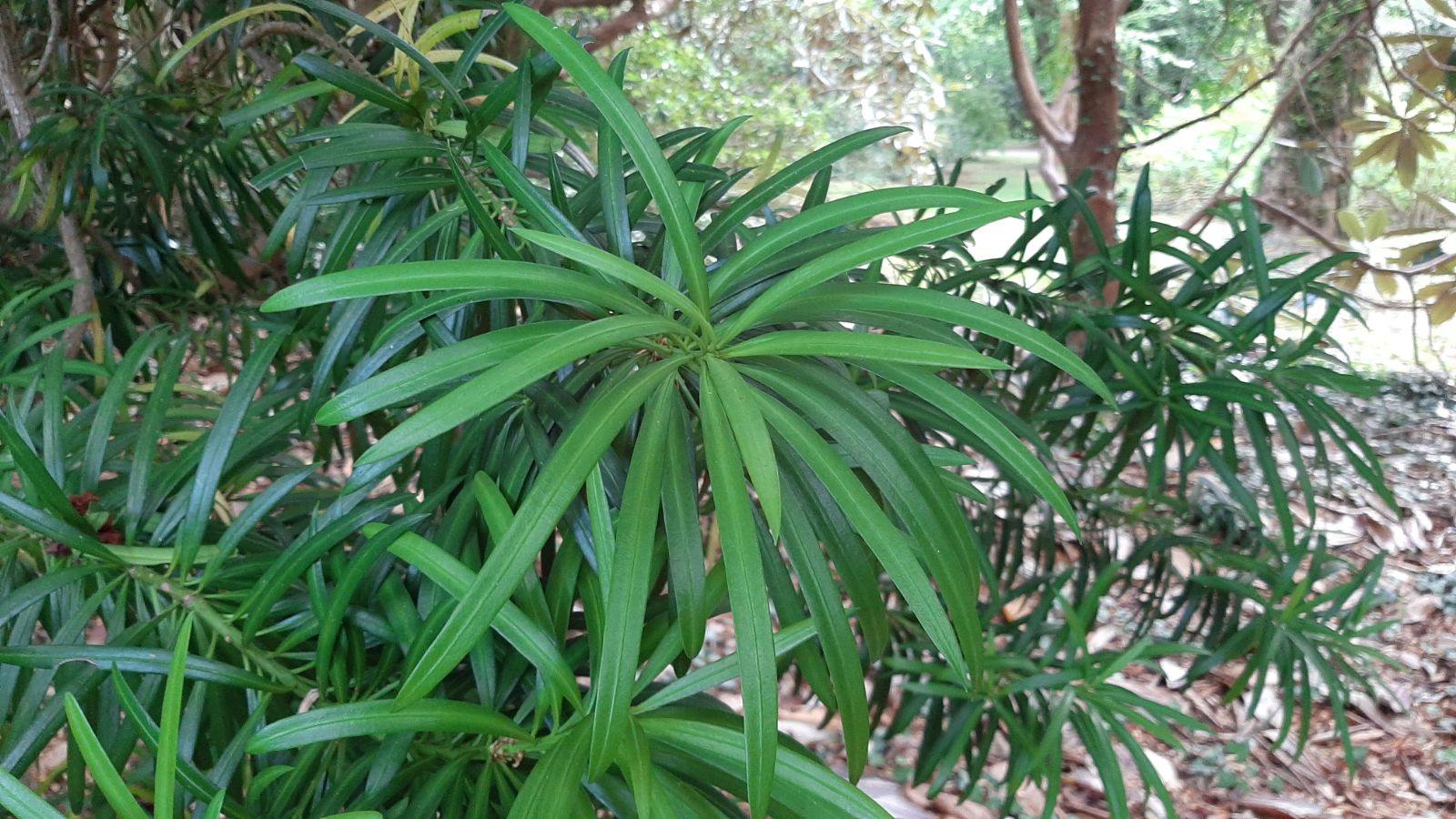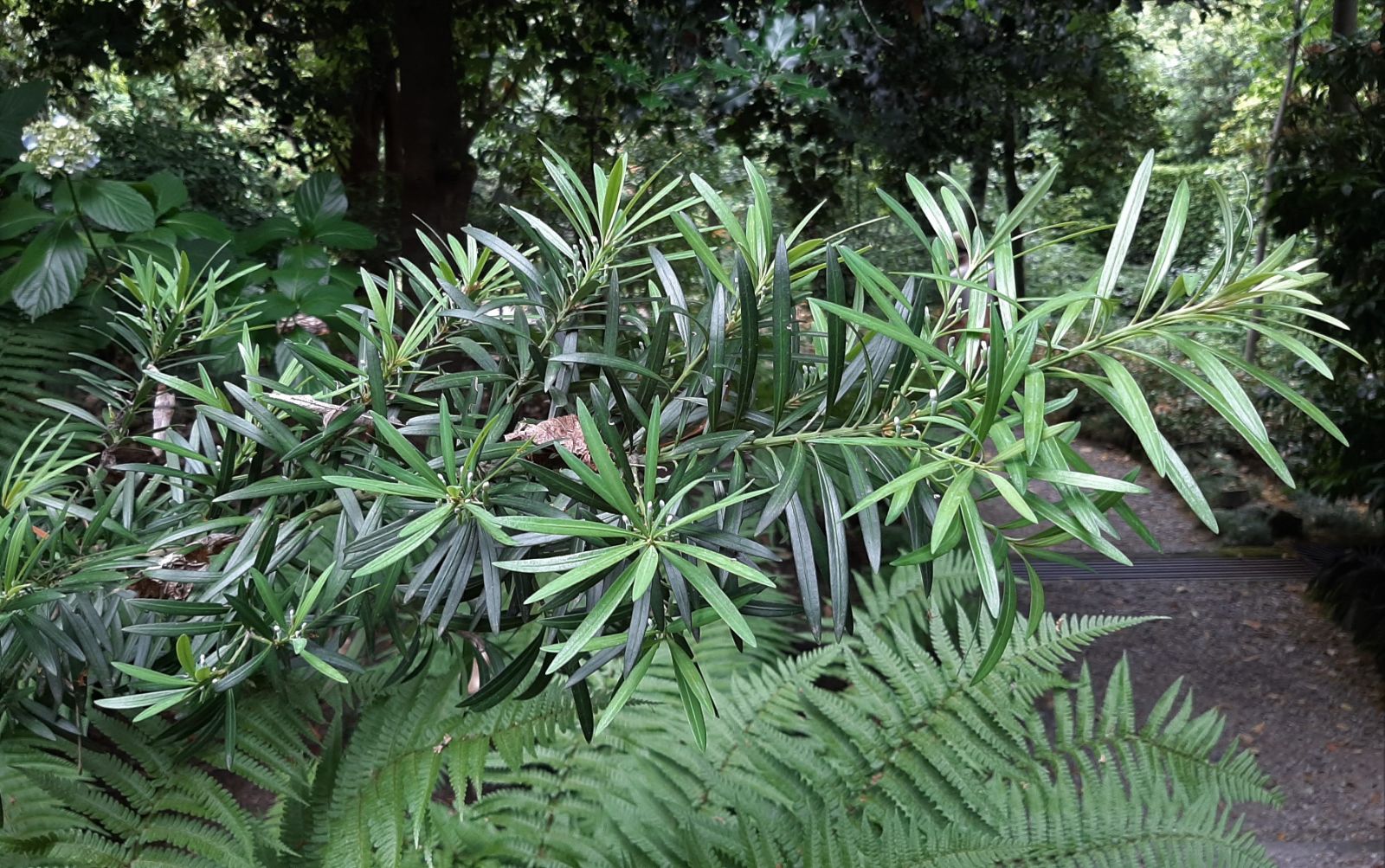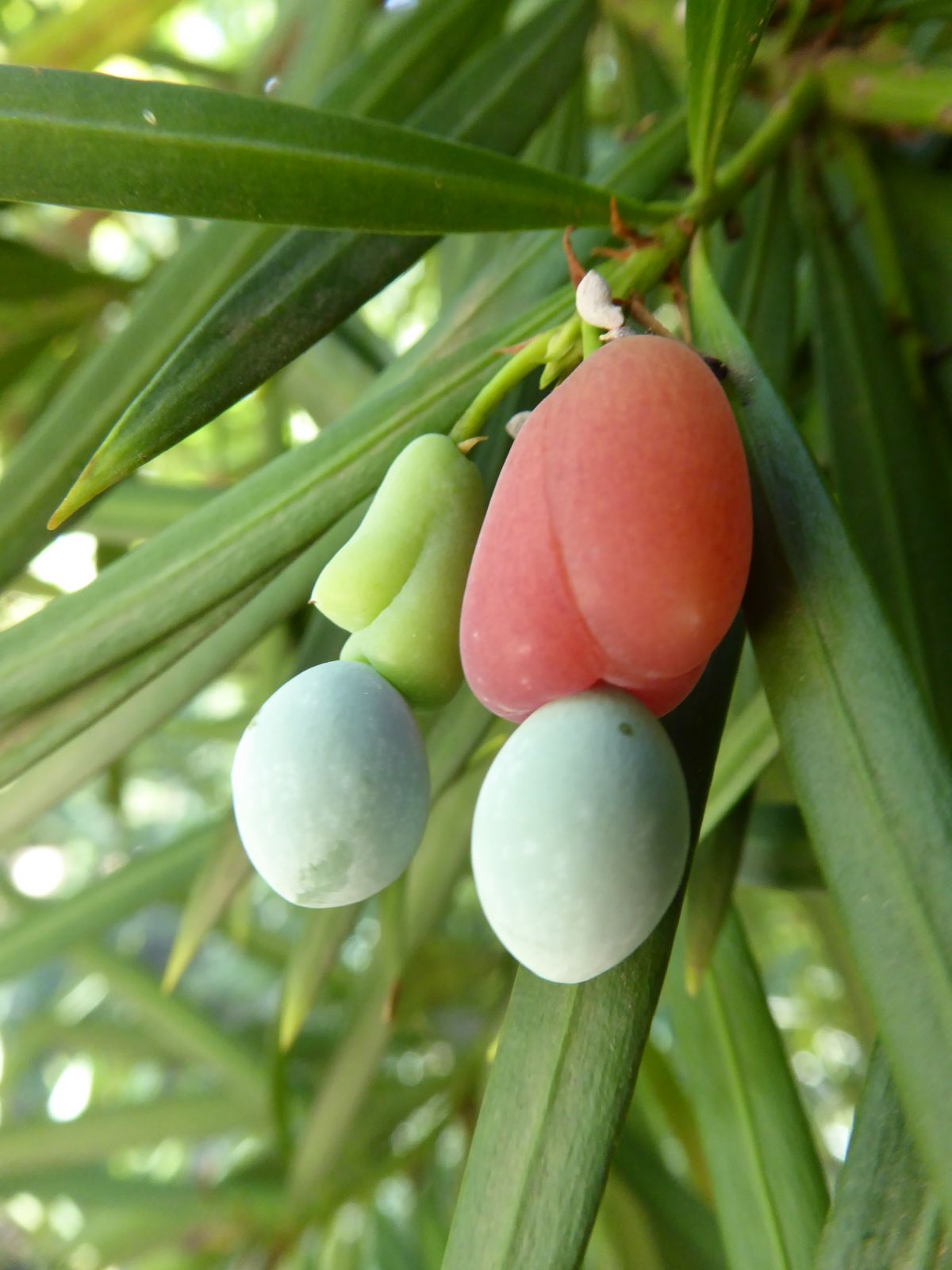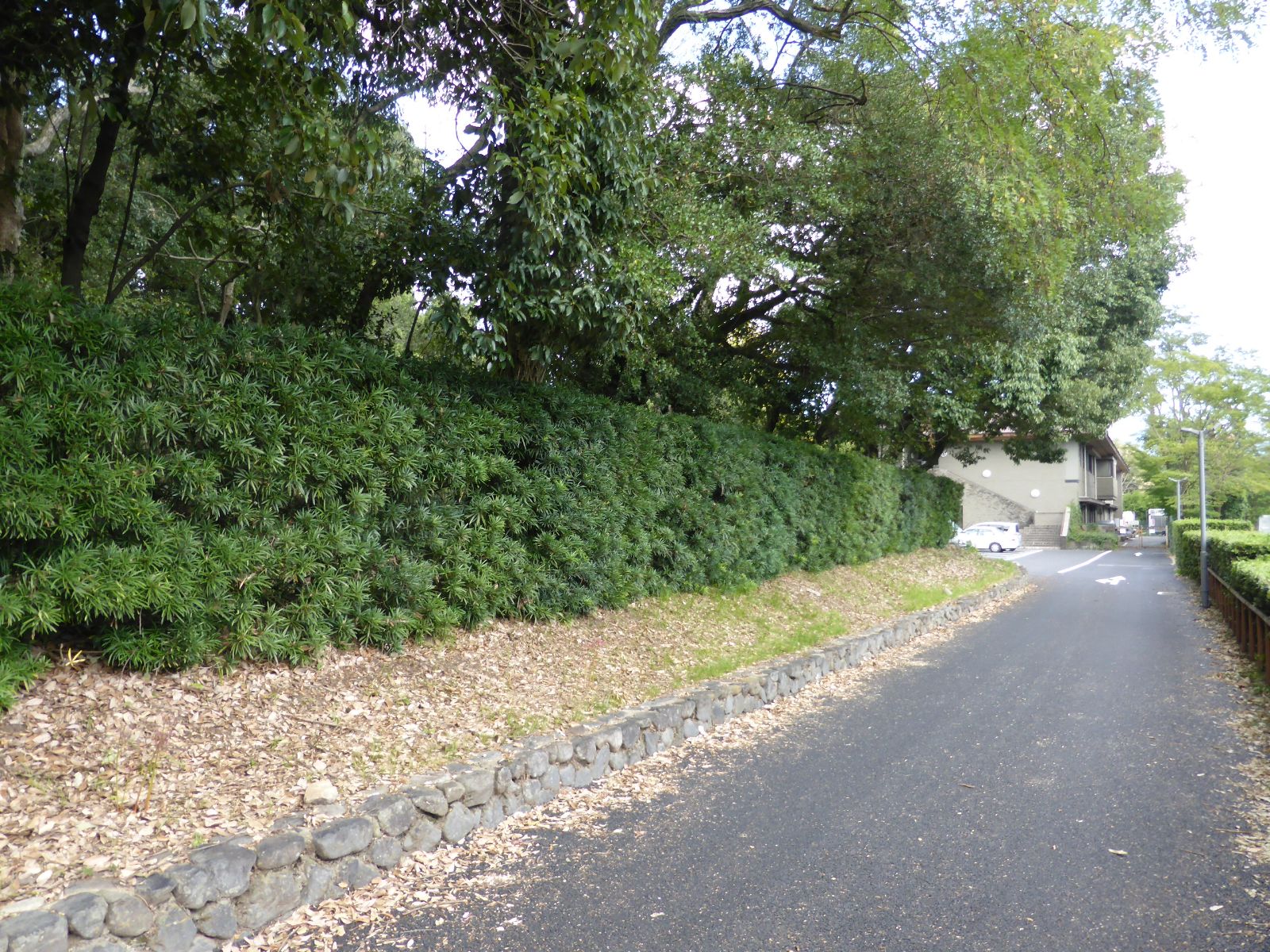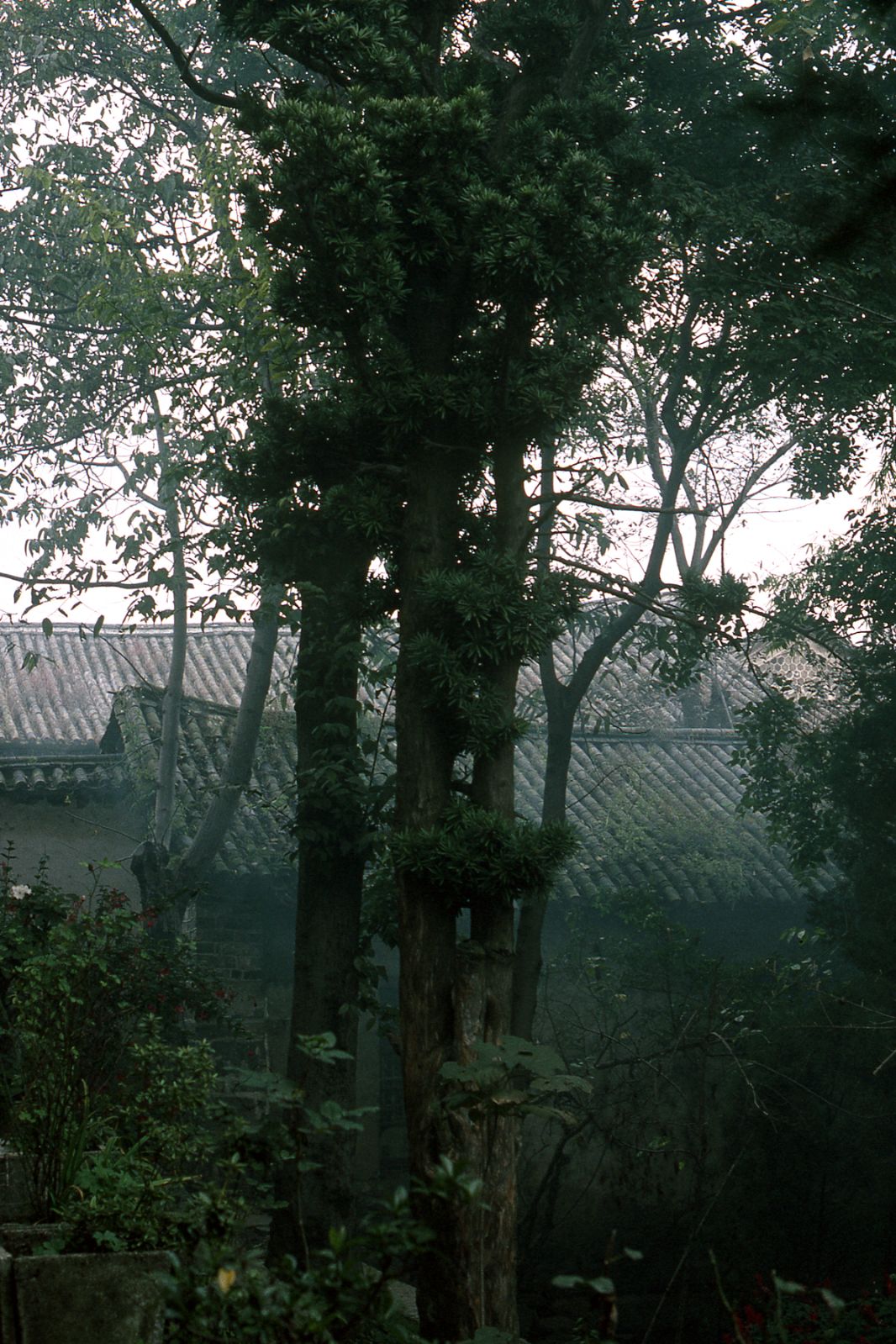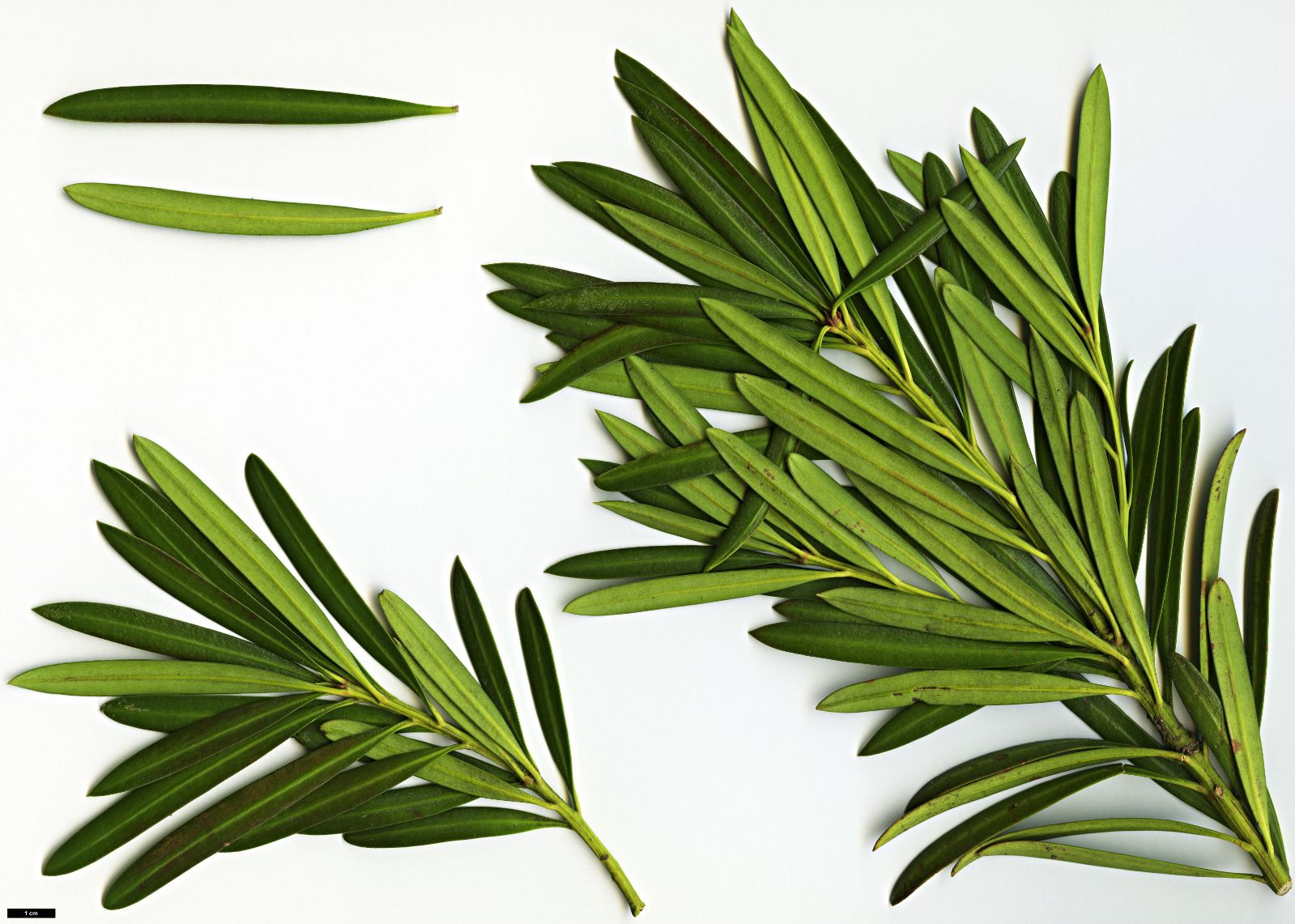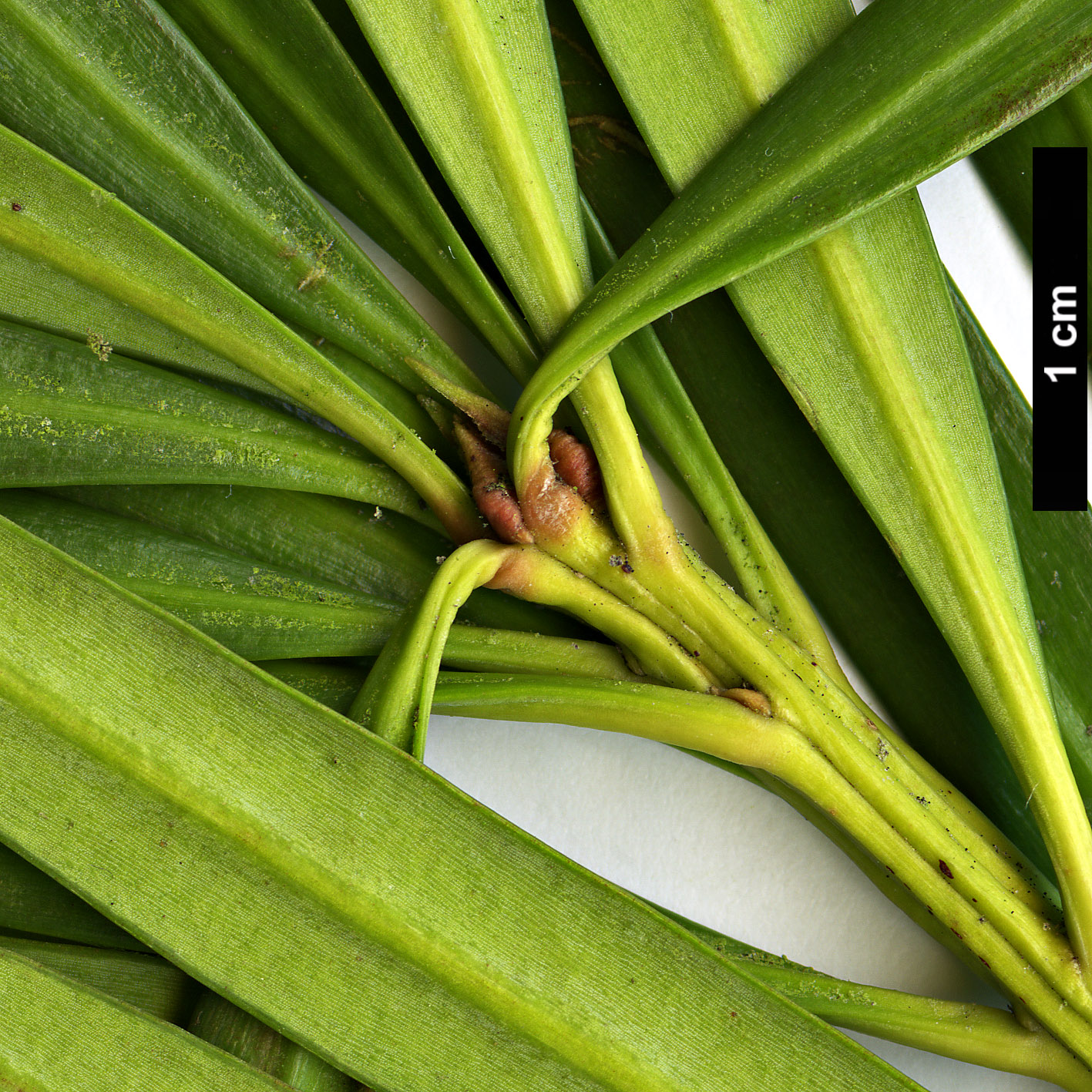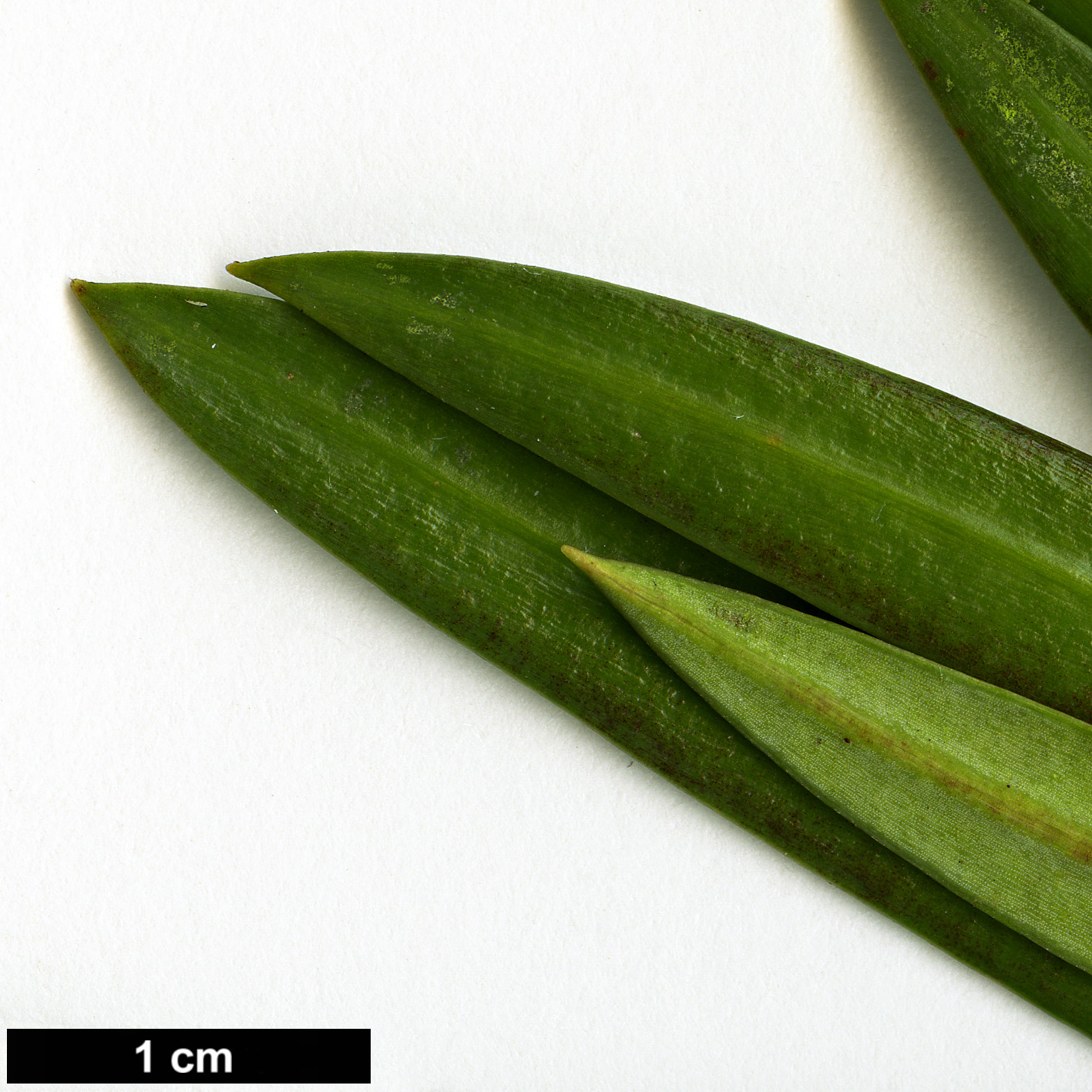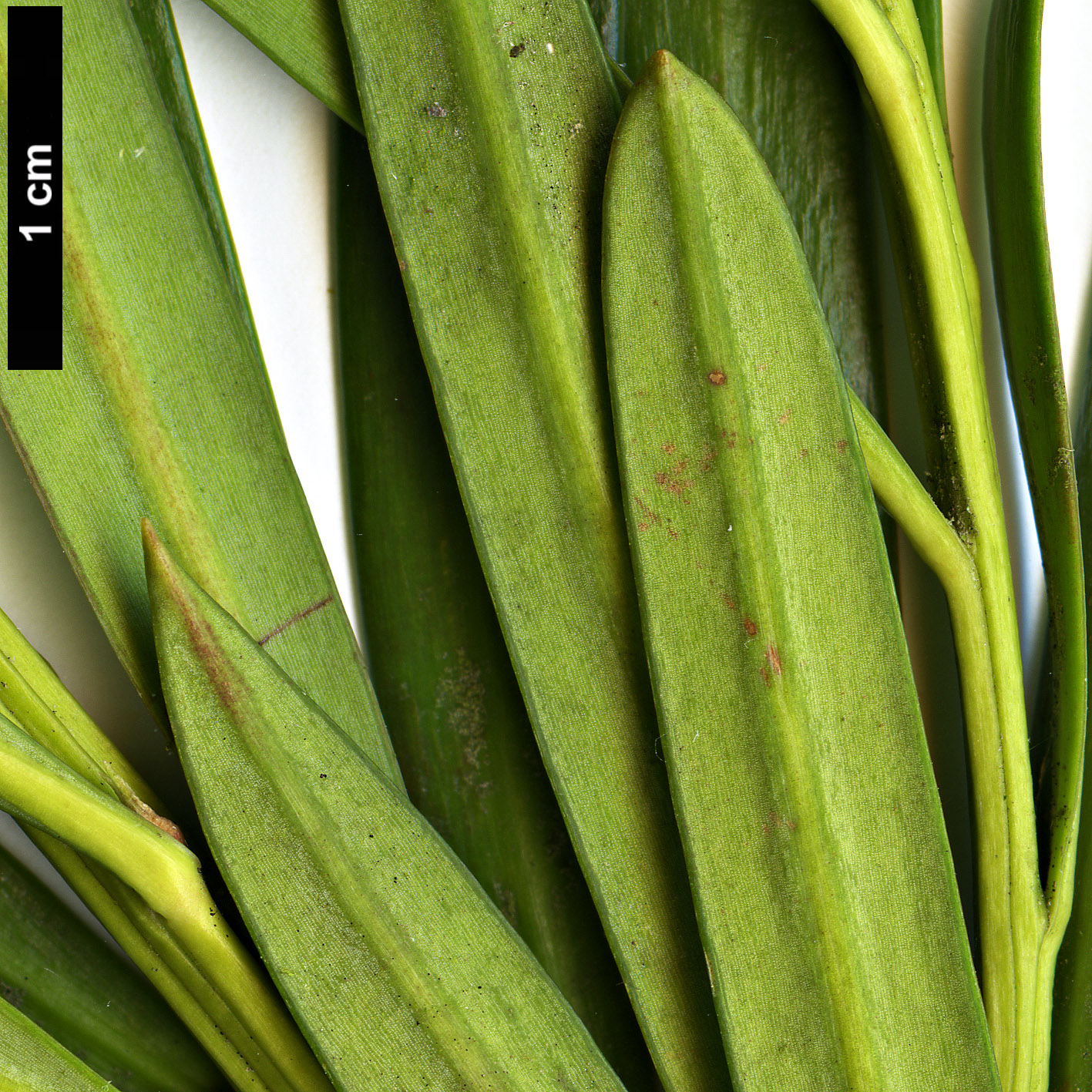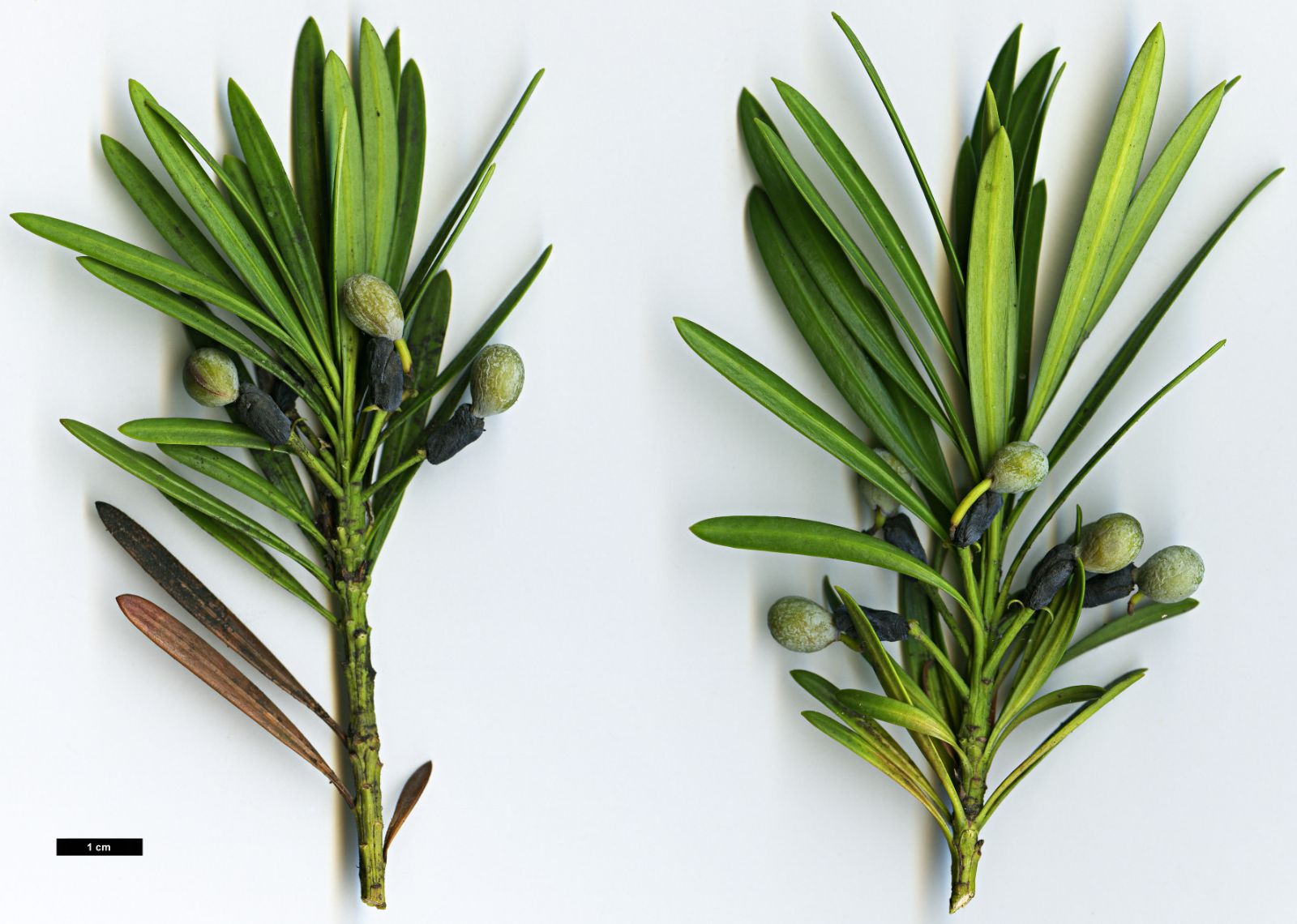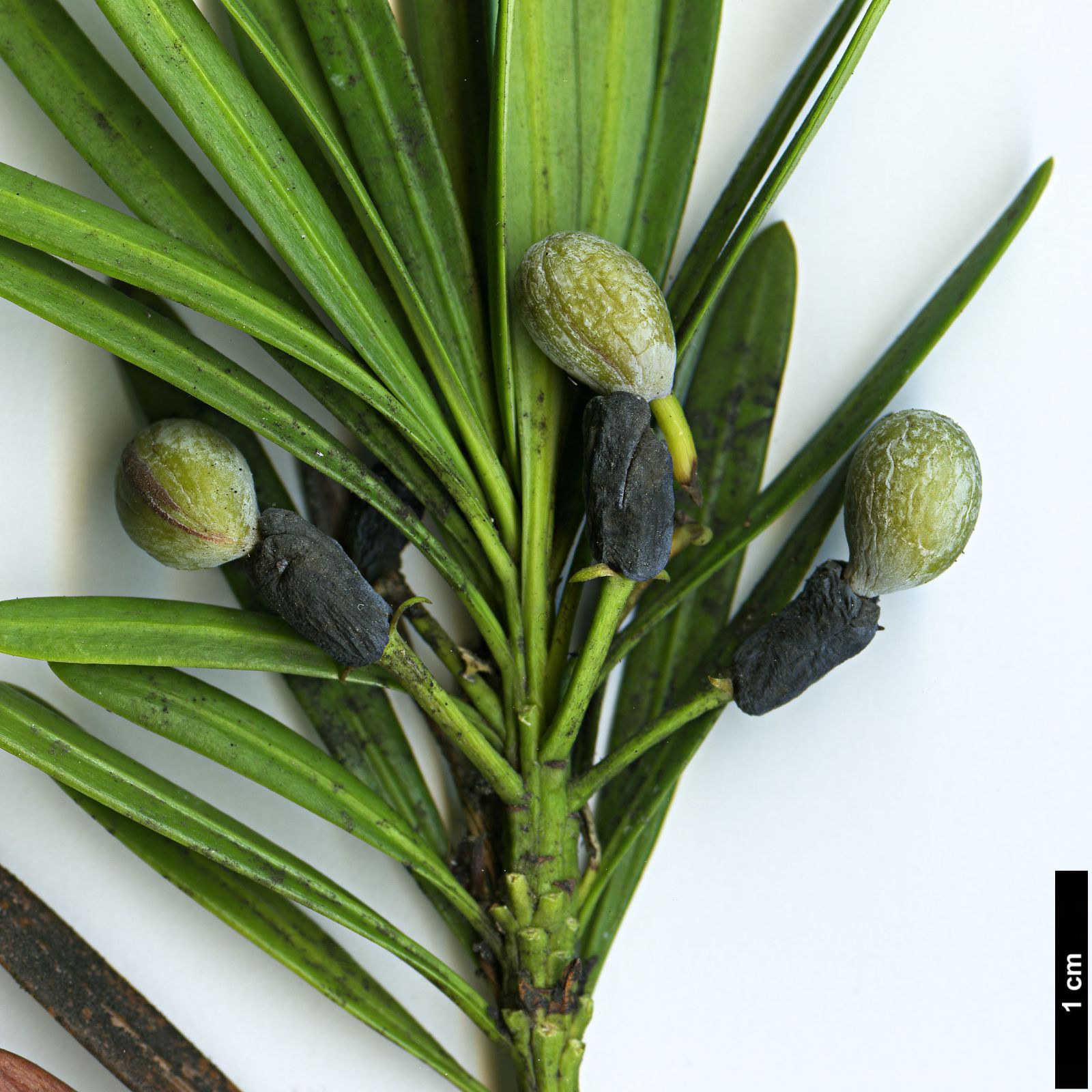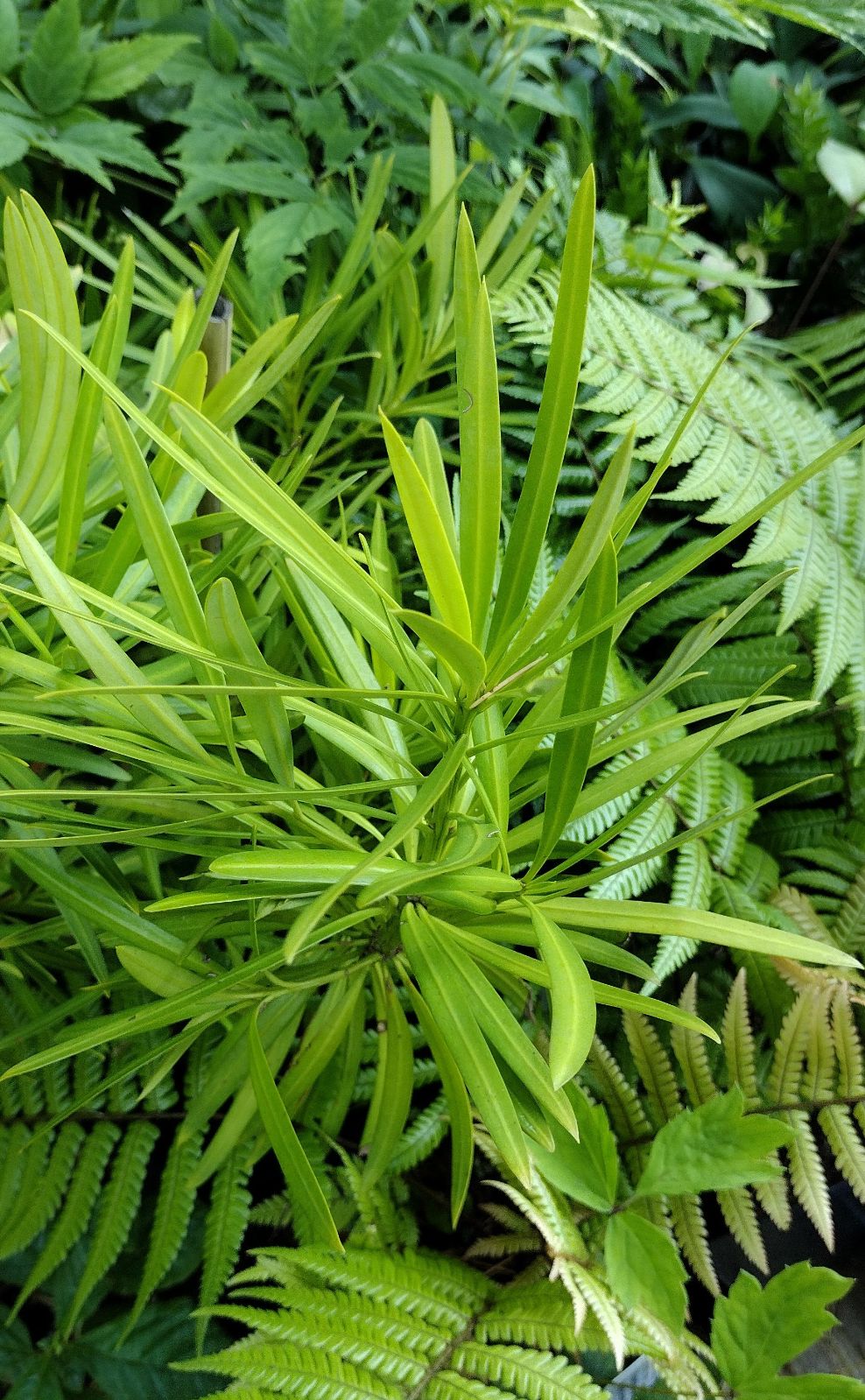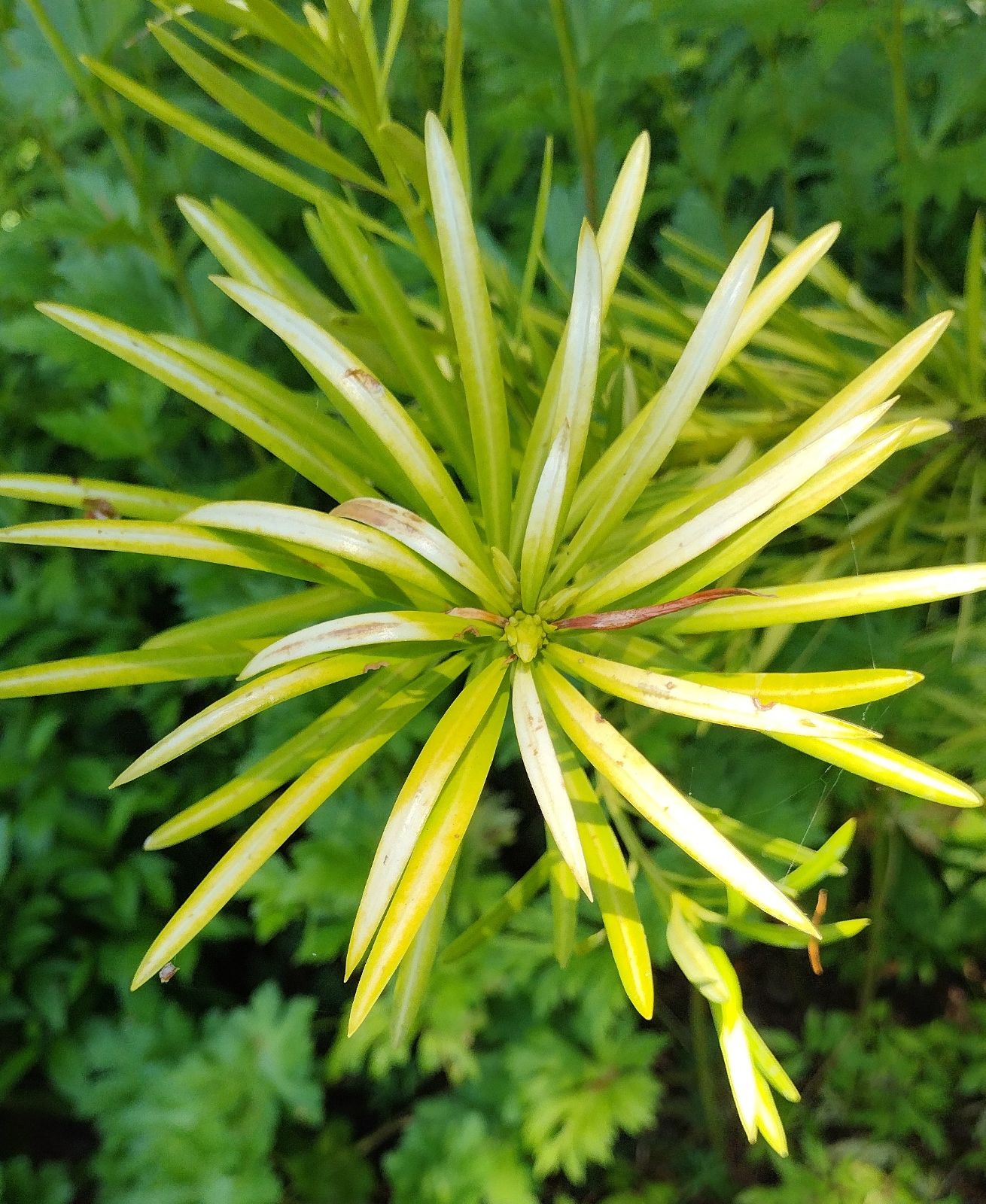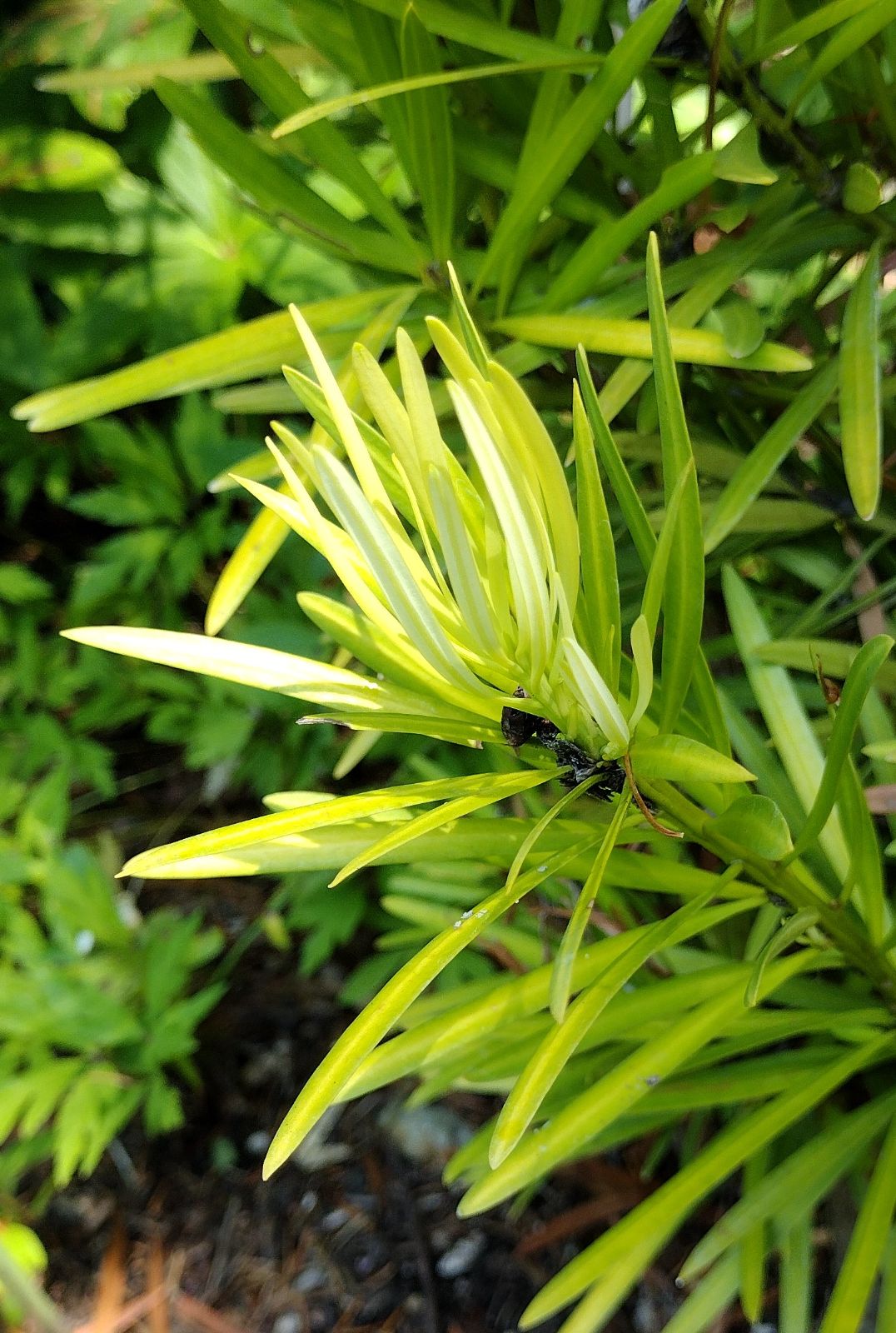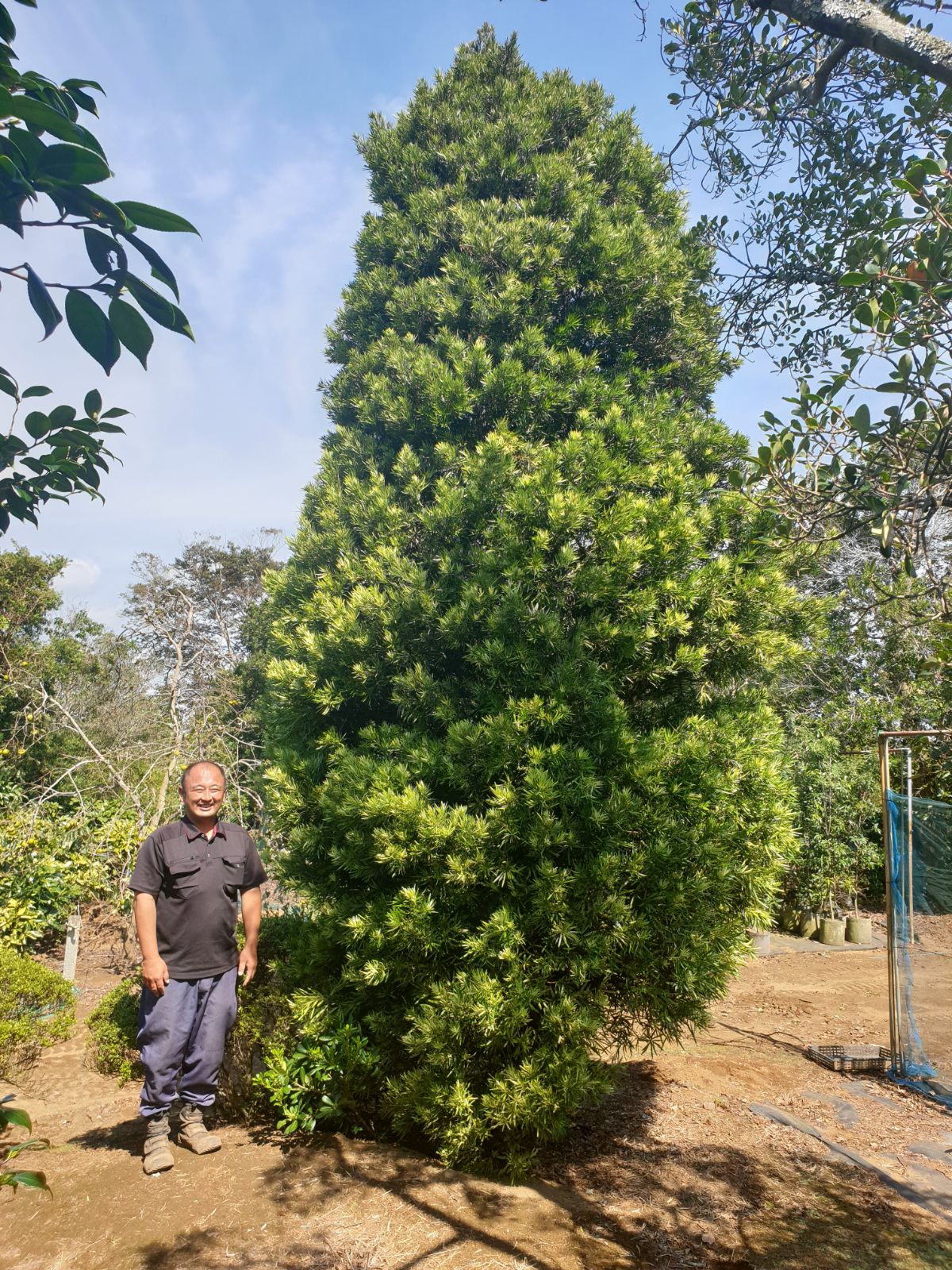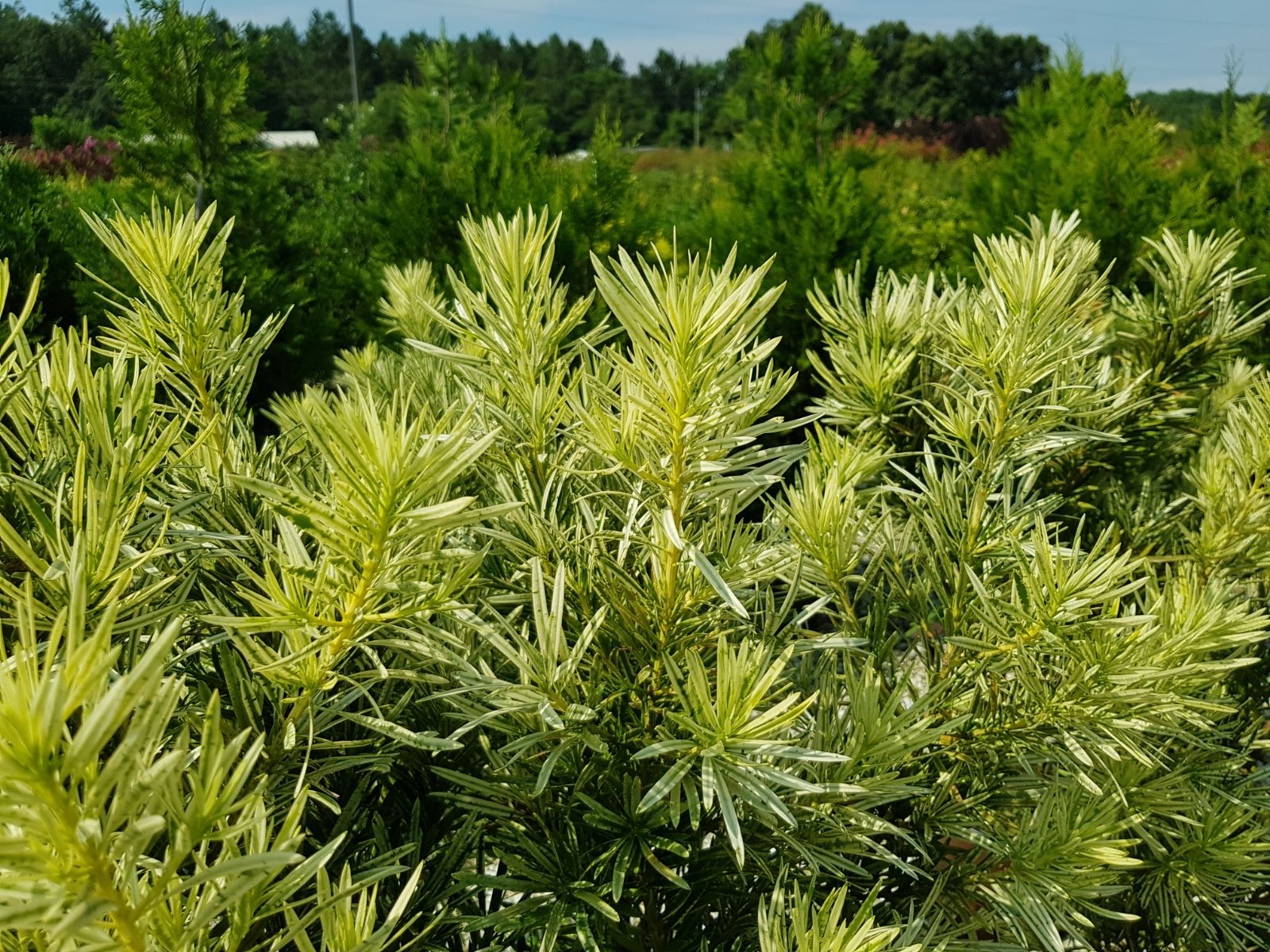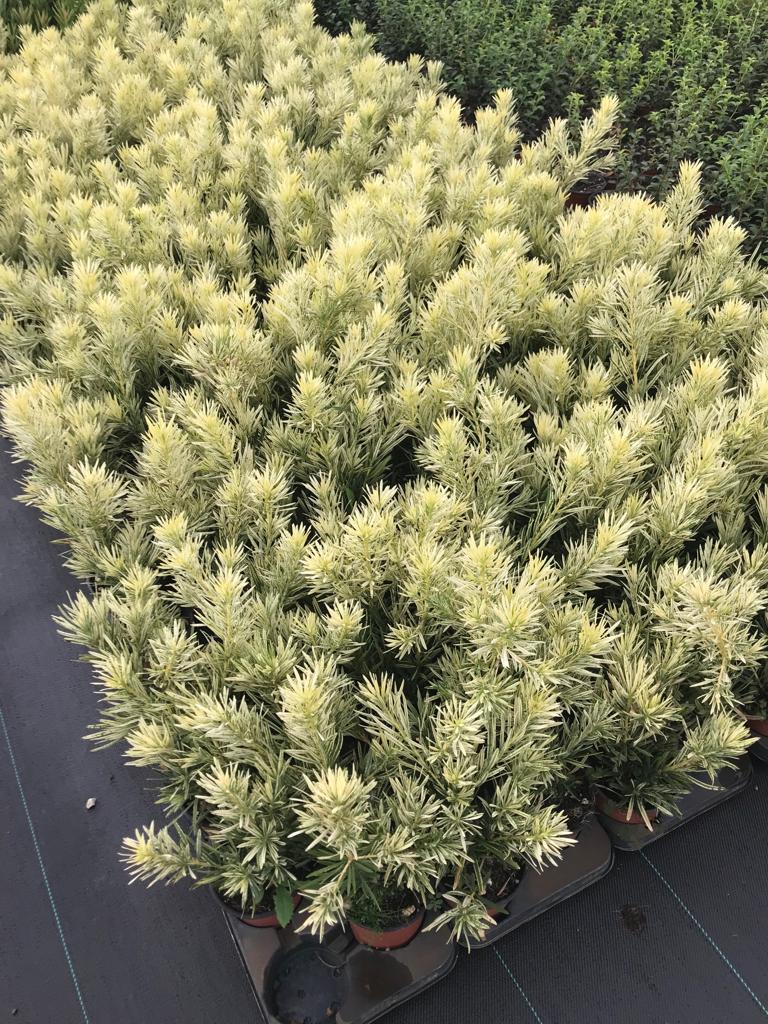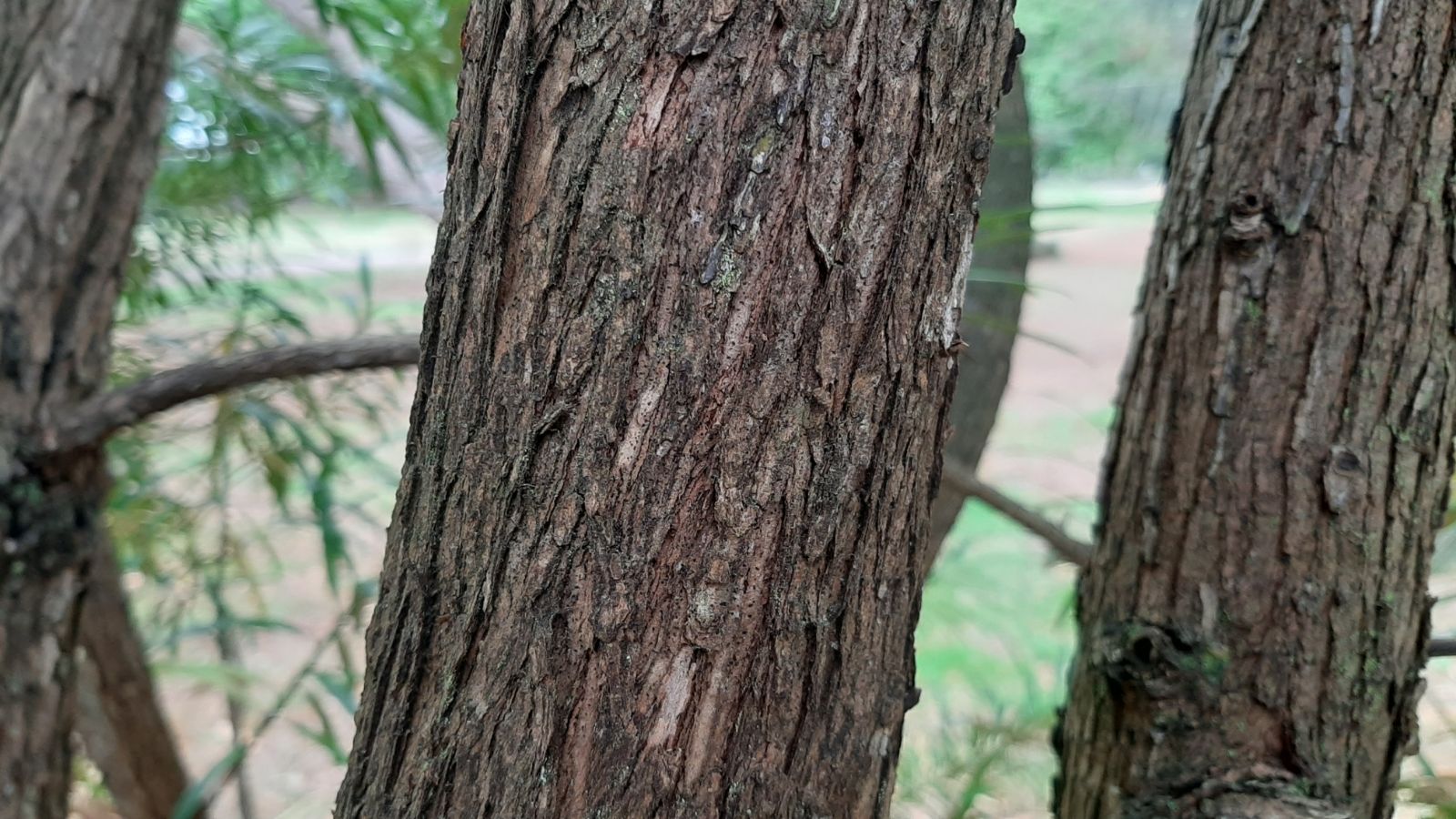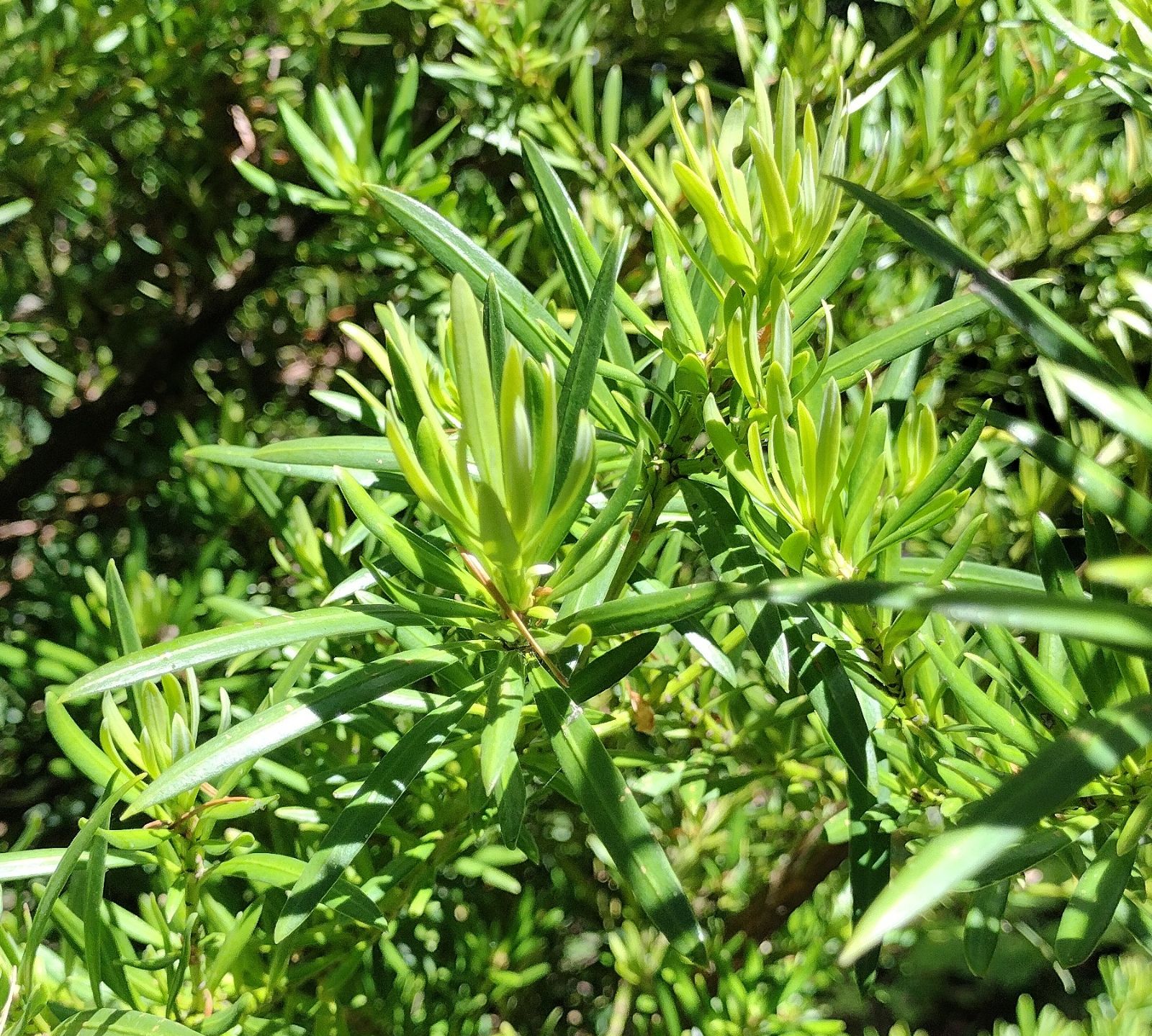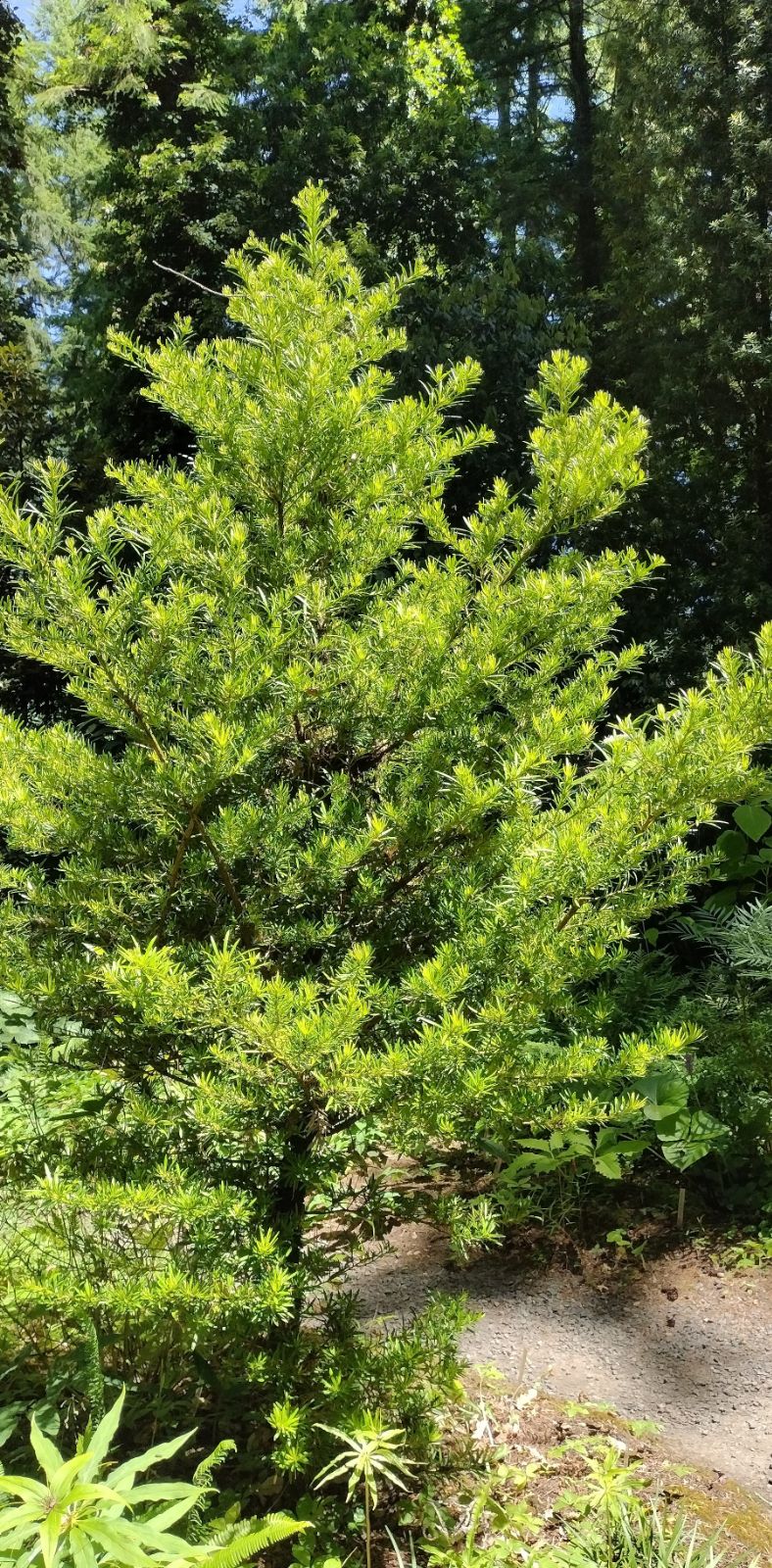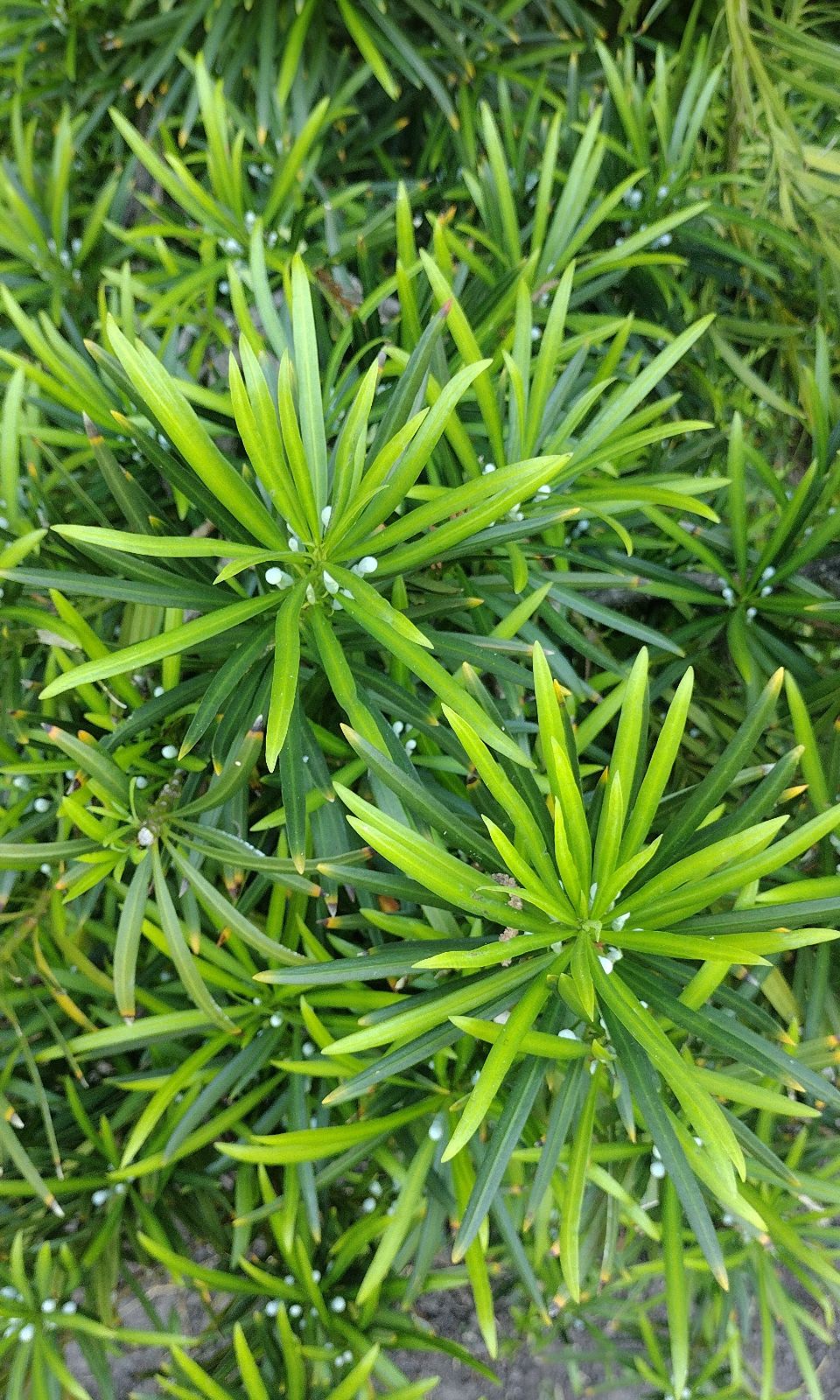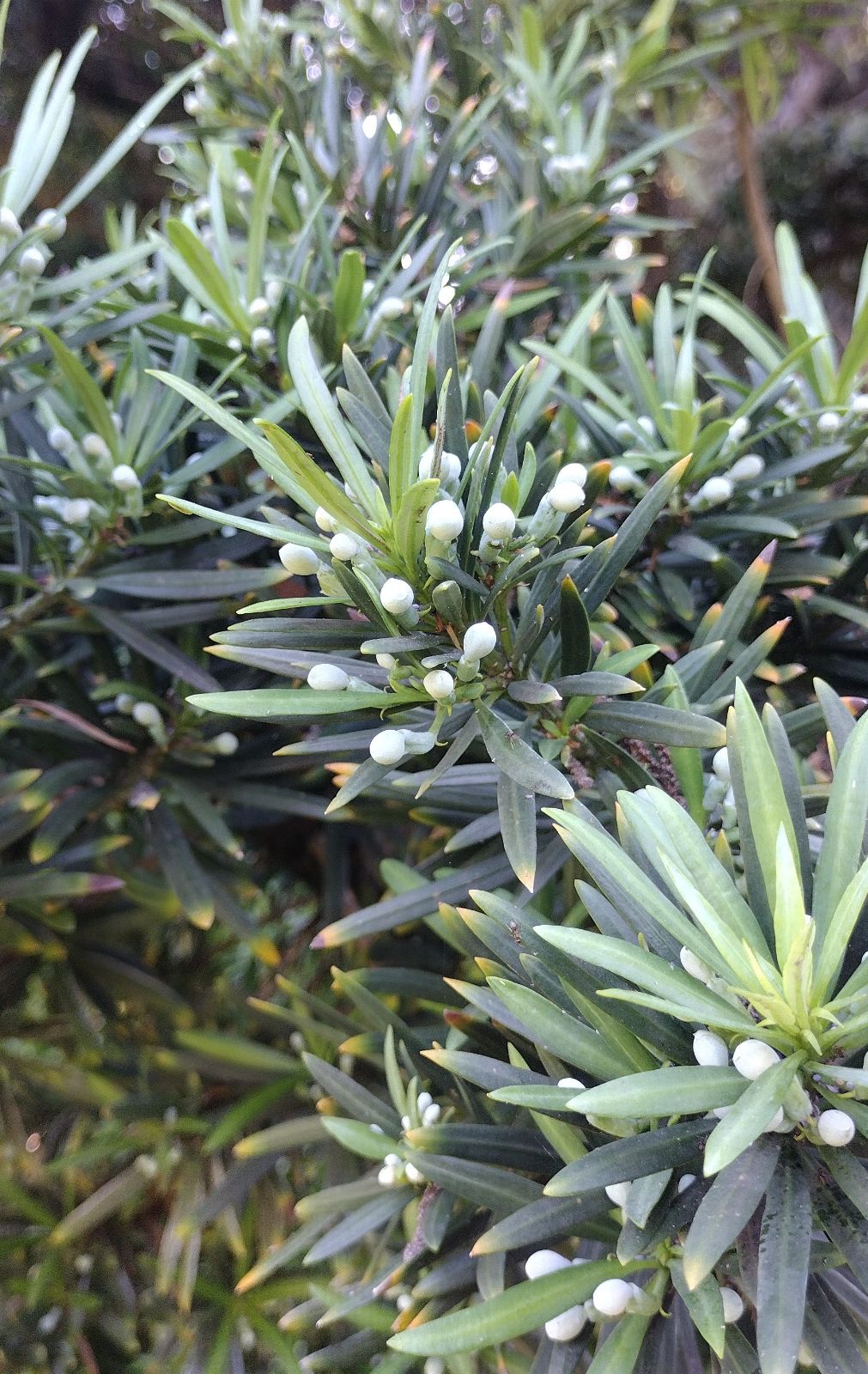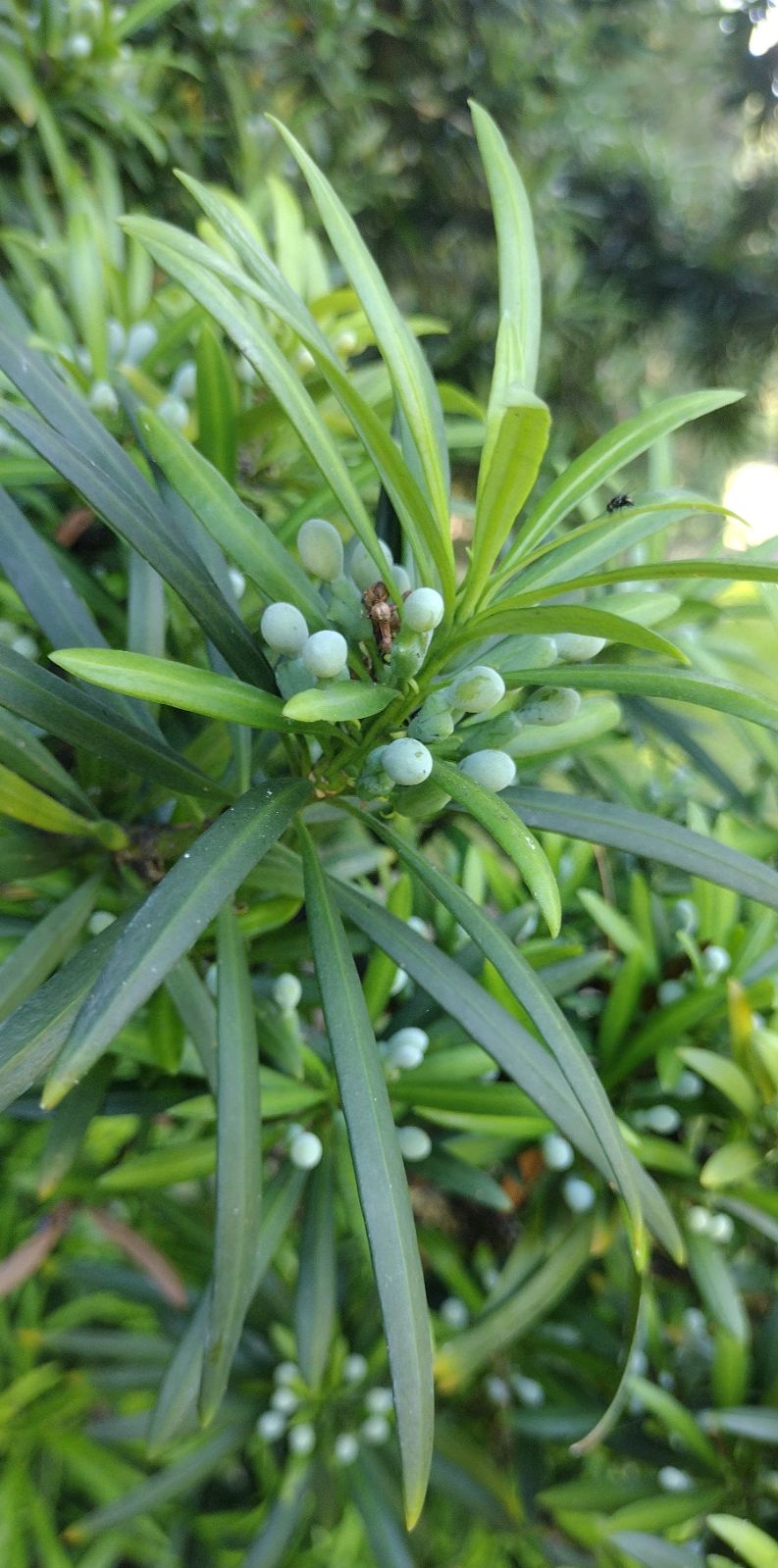Podocarpus macrophyllus
Sponsor
Kindly sponsored by
The British Conifer Society in memory of Derek Spicer VMM, founder member.
Credits
Tom Christian (2023)
Recommended citation
Christian, T. (2023), 'Podocarpus macrophyllus' from the website Trees and Shrubs Online (treesandshrubsonline.
Genus
Common Names
- Bigleaf Podocarp
- Buddhist Pine
- Kusamaki
- 罗汉松 (luo han song)
Synonyms
- Nageia macrophylla (Thunb.) A.V.Bobrov & Melikyan
- Podocarpus chingianus (N.E. Gray) S.Y. Hu
- Podocarpus forrestii Craib & W.W. Sm.
- Podocarpus sweetii C.Presl
- Taxus macrophylla Thunb.
Infraspecifics
Other taxa in genus
- Podocarpus acutifolius
- Podocarpus acutifolius × lawrencei
- Podocarpus acutifolius × nivalis
- Podocarpus acutifolius × totara
- Podocarpus brassii
- Podocarpus costalis
- Podocarpus drouynianus
- Podocarpus elatus
- Podocarpus elongatus
- Podocarpus guatemalensis
- Podocarpus henkelii
- Podocarpus laetus
- Podocarpus laetus × nivalis
- Podocarpus lambertii
- Podocarpus latifolius
- Podocarpus lawrencei
- Podocarpus lawrencei × nivalis
- Podocarpus matudae
- Podocarpus milanjianus
- Podocarpus nakaii
- Podocarpus neriifolius
- Podocarpus nivalis
- Podocarpus nubigenus
- Podocarpus oleifolius
- Podocarpus parlatorei
- Podocarpus pilgeri
- Podocarpus pseudobracteatus
- Podocarpus salignus
- Podocarpus spinulosus
- Podocarpus totara
Tree to 20 m tall, 0.6 m dbh, or a shrubby tree several metres tall. Bark smooth, grey or grey-brown, detaching in thin flakes. Branches spreading or ascending, densely set; branchlets angular, glabrous or rarely pubescent. Terminal buds with elongated, caudate, recurved scales. Leaves sessile or short-petiolate, spirally arranged, linear-lanceolate to somewhat falcate, 2.5–14 × 0.3–1.3 cm; midrib acutely but minutely raised above, obtuse below; blade rich dark-green above, pale to yellowish green below with very small stomata in irregular bands either side of midrib; base gradually tapering, slightly twisted, apex variably acute or acuminate (especially in juvenile plants), obtuse or apiculate. Pollen cones in clusters of (2–)3–5, sessile, subtended by several triangular bracts, long-cylindrical, 20–40(–50) × 2.5–3 mm. Seed cones solitary, axillary, on peduncles 5–15 mm long, subtended by two recurved bracts, columnar and glaucous before maturity, 10–15 × 2–3 mm, swelling to 10–12 mm across and becoming succulent, yellow, red, then purplish red at maturity; receptacle 5–6 mm at maturity, subtended by a single ovoid seed c. 4–10 × 2–8 mm, smooth, light brown. (Farjon 2017; Fu, Li & Mill 1999).
Distribution Myanmar China Anhui, Fujian, Guangdong, Guangxi, Guizhou, Hubei, Hunan, Jiangsu, Jiangxi, Sichuan, Yunnan, Zhejiang Japan Vietnam Taiwan
Habitat In forests, often along watercourses and in gorges, and in thickets and scrub on mountain slopes from sea level to 1000 m asl. Lower parts of its distribution have been subject to extensive deforestation, land use change and modification. In remnant undisturbed forests associates include various Fagaceae and Lauraceae, and the conifers Cunninghamia lanceolata, Pinus spp., Podocarpus neriifolius, Cephalotaxus fortunei, Fokienia hodginsii, Taxus chinensis, Pseudotsuga sinensis and Tsuga chinensis.
USDA Hardiness Zone 8-9
RHS Hardiness Rating H3
Conservation status Least concern (LC)
Podocarpus macrophyllus has a broad distribution from the eastern edge of the Tibet-Qinghai Plateau through warm-temperate to sub-tropical parts of China, Myanmar, Vietnam and Japan, as well as the island of Taiwan, primarily below c. 1000 m asl (Farjon 2017; Debreczy & Rácz 2011)). With such a distribution it should come as no surprise that this is a species whose greatest horticultural potential may be realised outside our proper study area, in areas with hot summers and mild winters, such as the southern states of the USA, mediterranean and subtropical regions of central and South America, southern Africa, Australia and New Zealand. In many of these areas, most especially the southern USA, P. macrophyllus is a significant and widely grown ornamental while for centuries, perhaps millennia, it has also been extensively planted throughout its native range (especially var. maki – Farjon 2017). Numerous cultivars have been selected, including many with brightly coloured new growth, while others are spreading or compact. They will tolerate clipping and the species is often used as a hedging or screening plant, but when allowed to grow naturally forms a small, reasonably narrow tree.
In a genus already difficult to characterise in a work focused on temperate areas, P. macrophyllus may be one of the more difficult species to discuss. Had this account been written twenty years ago, at the start of the new millennium, it would have been easy to dismiss this species as half-hardy, suitable only for the mildest gardens on the fringes of our study area, but now it seems set to become one of the horticultural beneficiaries of climate change. In the last twenty years more adventurous growers have tested P. macrophyllus beyond its traditional limits and their experiments have often met with success. Of course, particularly cold winters are still an enemy, and cool summers can drastically hold back growth, but the emerging trend for prolonged, warm summers in parts of north-west Europe is making P. macrophyllus less of a gamble with each passing year. It seems likely that certain clones in general circulation are hardier and more vigorous than others, but these have not yet benefited from sufficient attention to enable meaningful comparisons to be made here.
P. macrophyllus sits at the centre of one of the many vexatious species complexes in this genus: in its orbit are numerous entities including its widely accepted var. maki (most reliably distinguised by its wider leaves, but there is overlap with var. macrophyllus – Farjon 2017). Var. maki is probably the commonest form of the species in general cultivation in the west and most of the early introductions likely belonged here (Grimshaw & Bayton 2009). Several late 20th century introductions, from relatively high altitude in western China, have been made under the names P. chingianus and P. forrestii, names whose position and rank, and indeed any validity at all, is subject to ongoing debate. Certainly plants labelled P. chingianus and P. forrestii are strikingly similar to P. macrophyllus (var. macrophyllus) and technical literature suggests that they fall within the accepted variation of this species (indeed, P. chingianus was originally described as a variety of P. macrophyllus but later elevated to species rank, while conifer specialists Aljos Farjon (2001, 2017) and David de Laubenfels (1985) both consider P. forrestii synonymous with P. macrophyllus var. macrophyllus and this view is adopted here. Besides the taxonomic difficulties inherent in this genus (discussed in the genus article) the long use of P. macrophyllus (especially var. maki) and perhaps some of its close relatives in gardens and forestry within and near to its native range, from where birds will have dispersed it yet further, has muddled the picture considerably; in some areas the ‘nativeness’ or otherwise of populations is not at all clear, compounding the difficulties facing researchers. In time these satellites will probably come to be more widely regarded as part of a broad interpretation of P. macrophyllus. We include them in synonymy here but discuss the history of these names, and introductions made under them, under appropriate subheadings below. P. nakaii is another P. macrophyllus lookalike endemic to mid- to high-elevations in Taiwan; we give this taxon the benefit of the doubt and discuss it separately. P. neriifolius overlaps with P. macrophyllus in south east Asia but is quite distinct (Debreczy & Rácz 2011).
It is probable that most of the cultivars discussed here belong to var. maki but we follow the authoritative Encyclopaedia of Conifers (Auders & Spicer 2012) in not distinguishing them to infraspecific level. Indeed, most cultivated P. macrophyllus within our area are probably var. maki (except those introduced as P. chingianus and P. forrestii) but few labels and databases make the distinction; the various characters and dimensions used to distinguish them are all variable, the most reliable are cited in the key below.
Podocarpus chingianus
Ostensibly distributed in Jiangsu, Zhejiang and perhaps Sichuan, this entity is poorly understood as a wild plant. It was originally described as a variety of P. macrophyllus in 1958, based on a single collection from Zhejiang deposited at the Arnold Arboretum herbarium. Hu elevated it to species rank in 1964 based on study of additional material; he described its habitat as secondary woodland and shrubland over an inferred altitudinal range of 0–1000 m asl (Farjon 2017). Hu’s treatment has generally been followed ever since, although it was treated as a P. macrophyllus cultivar in the Flora of Zhejiang Province (1993); its occurrence in Sichuan has never been confirmed (Farjon 2017). John Silba distributed material of known wild origin, traceable to Zhejiang, to multiple institutions in the 1990s. Plants were received at the Royal Botanic Garden Edinburgh in 1995 simply marked ‘C-5526’; the following year a rooted cutting deriving from the same collection arrived via Pinetum Blijdenstein. Plants from these introductions survive under glass at Edinburgh and outdoors at Bedgebury National Pinetum where a single plant was sent in 2003 when it was 80 cm; it was 1.6 m in 2010, after which it was severely hampered by the extremely cold winter of 2010–11. It had recovered to only 1.7 m by 2018 (pers. obs.) and five years later continues to limp along (D. Luscombe pers. comm. 2023). A plant accessioned at Tregrehan in 1995 had made a 4 m tree by 2017 (Smith & Hudson 2017). The UK’s National Trust has distributed cutting-raised material several times through the 2010s. All these plants are rather upright in habit with conical-columnar crowns.
Podocarpus forrestii
Described from Forrest collections gathered on the Tali Shan in August 1906 (F 4665). Forrest’s notes, including from subsequent expeditions, describe shrubs to c. 3 m growing in scrub and dry places at 2400–3000 m asl (herbarium specimen data). There is no indication that Forrest introduced living material and no wild plants have been reported since (P. Thomas pers. comm. in Grimshaw & Bayton (2009)). Material was introduced under this name in the early 1990s from a group of cultivated trees growing in and around the First Middle School in Dali. Maurice Foster recalls two plants growing in the school grounds, one distinctly shrubby and one more tree-like (M. Foster pers. comm. 2022) one male and one female. Various western collecting teams have sampled these accessible plants, including the Chungtien, Lijiang and Dali (CLD) expedition in 1990 (CLD 1565 and 1566B) material from which remains under glass at the Royal Botanic Garden Edinburgh, and the Alpine Garden Society expedition of 1994 under ACE 2543A (the male plant, as cuttings) and 2543B (the female, as a few seeds and cuttings). ACE 2543A is represented in several UK collections, including Tregrehan, where despite the mild, moist climate, growth has been extremely slow: dispatched there from Edinburgh in 2002 when 70 cm tall, by 2022 it remained only 1.5 m (pers. obs.). Two plants from ACE 2543B survived at Bedgebury, Kent: in 2010 when these were 50 and 55 cm, with growth then averaging just 2 cm per year (pers. obs.); in early 2023 they remain stunted, small, disappointing plants (D. Luscombe pers. comm.). A better plant grows in Maurice Foster’s arboretum at White House Farm, also Kent; this was approaching 2 m and growing vigorously in June 2022 (pers. obs.).
Identification key | ||
| 1a | Plants generally tree like (in optimal climates); adult leaves (3–)5–10(–11) × (0.5–)0.7–1(–1.3) cm, apex abrupt, usually obtuse or apiculate | var. macrophyllus |
| 1b | Plants generally shrubby; adult leaves (2.5–)3.5–7(–8) × 0.4–0.7(–0.8) cm, apex less abrupt, usually acute or acuminate, sometimes obtuse | var. maki |
'Angustifolius'
Synonyms / alternative names
Podocarpus macrophyllus var. angustifolius Blume
A vigorous tree to about 15 m with relatively narrow, rather long leaves (c. 50–120 × 3–9 mm) flushing yellow-green, later maturing rich dark green, tips acuminate to subacute. It was introduced to St Petersburg Botanic Garden from Japan by Carl Maximovich in 1864 (Auders & Spicer 2012) and became commonly planted in the USA in particular (Krüssmann 1985). This plant has been treated as a variety, var. angustifolius Blume (e.g. Krüssmann 1985) but it is better treated as a cultivar. Scientific literature usually synonymises Blume’s name with var. macrophyllus (e.g. Farjon 2017). Its proportionately narrow leaves suggest var. maki while its strong, tree-forming habit suggests var. macrophyllus.
'Argenteus'
Synonyms / alternative names
Podocarpus macrophyllus 'Albovariegatus'
Podocarpus macrophyllus 'Argenteovariegatus'
Leaves margined or striped white. Introduced from Japanese cultivation to England by Robert Fortune in about 1861 and again by J.H. Veitch in 1892 (Auders & Spicer 2012; Bean 1976).
'Aureus'
Synonyms / alternative names
Podocarpus macrophyllus 'Aureovariegatus'
Podocarpus macrophyllus 'Luteovariegatus'
Leaves with a broad yellow margin and sometimes longitudinal yellow stripes, larger than typical for the species. Contradictory accounts of its introduction to Europe occur in literature, including suggestions that von Siebold sent material to the Netherlands from Japan c. 1845 (Hatch 2021–2022) but von Siebold was back in the Netherlands by 1830 and didn’t return to Japan until 1859. Bean points to two known introductions, one by Robert Fortune in 1861, and another by J.H. Veitch in 1892 (Bean 1976).
'Brodie'
Reporterd by Dirr (2009) to be a spreading, compact plant: he also notes ‘Spreading’ as a similar selection for groundcover use.
'Edgefield Hardy'
Synonyms / alternative names
Podocarpus macrophyllus 'Edgefield'
Selected in Edgefield, South Carolina, by Dr Dan Horton of the University of Georgia, this is an erect, hardy clone (Dirr 2009): it is reported (Nurseries Caroliniana 2023) to have withstood –20oC (–4°F) in 1985 without damage. The foliage is slightly more glaucous, and about three-quarters the size of standard var. maki: the developing seeds and receptacles are distinctly blue and showy in their early stages (Hatch 2018–2020).
'Golden Crown'
A golden-leaved cultivar of uncertain origin, but apparently grown in collections across the United States. Online images suggest that it will form a narrowly upright specimen that can be quite spectacular as the new growth flushes bright yellow. The leaves become greener as the season progresses. More information would be welcome.
'Hillier's Compact'
Synonyms / alternative names
Podocarpus macrophyllus var. compactus Hort.
A very slow growing shrub with small leaves, 60–80 × 6–9 mm, the midrib prominently raised on both surfaces. It was selected from a plant on the Hillier Nurseries, who coined the name var. compactus, in 1964 (Auders & Spicer 2012) but is probably no more than a stunted form of var. maki.
‘Nana’ seems similar, being described as ‘a bushy, rounded compact clone’ (Dirr 2009).
'Irvington'
A tightly columnar to narrowly conical selection which can grow to 5 m tall with a canopy spread of just ~1 m. A female clone, it can be attractively covered in red fruits. It is reportedly more cold hardy than the majority of cultivated material, with examples growing well in Portland, Oregon (Hatch 2018–2020). Hatch also describes ‘Upright Columnar Cliff’, raised and named by the Chapel Hill Nurseries, North Carolina: it is strikingly similar in all attributes to ‘Irvington’, which could just be a re-naming of the Chapel Hill clone.
'Lemon Sparkler'
Introduced to North American commerce by Nurseries Caroliniana c. 2018, this plant was given to the proprietor Ted Stephens by Dr. Masato Yakoi, and has clear yellow new growth throughout the season and an upright habit. The yellow colour of the foliage is best in full sun (Nurseries Caroliniana 2023).
'Miu'
Synonyms / alternative names
Podocarpus macrophyllus ROMAN CANDLE™
A selection of Japanese origin with new growth yellow to creamy white, becoming mottled yellowish as it matures, often developing a creamy margin. Introduced by Kenichi Kawaguchi of Sosa, Japan, and marketed in the US under the trade designation Roman CandleTM by Southern Living Plants from 2017 (Hatch 2018–2020).
'Okina'
Likely a mutant of ‘Argenteus’, differing in the variegation being less clearly defined, somewhat paler, and more randomly distributed across the lamina. The mame means ‘old man’, which seems very apt for this silvered, dome-forming small plant. Introduced to US commerce by Barry Yinger’s Asiatica Nursery c. 2006. ‘A very subtle collectors item’ (Hatch 2018–2020), or ‘an amazing focal point in the garden’ (Nurseries Caroliniana 2023). Take your pick.
'Pringle's Dwarf'
Synonyms / alternative names
'Pringlii' nom. illegit.
According to Ted Stevens (Nurseries Caroliniana 2023) this selection was made by Tom Dodd, Jr. of Tom Dodd Nursery, Semmes, Alabama, as a dwarf male clone (although Hatch (2018–2020) has seen female plants under this name at the JC Raulston Arboretum). It has been sold under the illiegitimate name ‘Pringlii’.
It is a slow-growing compact plant, ultimately achieving 100–150 cm (Nurseries Caroliniana 2023).
'Royal Flush'
Synonyms / alternative names
EMERALD FLAME
A selection in US commerce with new growth flushing shades of pinkish-red and orange throughout the growing season (Nurseries Caroliniana 2023). It was given to Ted Stevens of Nurseries Caroliniana as a single cutting by Dr Masato Yokoi prior to 2017 (Hatch 2018–2020, Nurseries Caroliniana 2023) and is now widely available under the trade name Emerald Flame.
'Sekka'
Shoot tips fasciated, otherwise typical. Of likely Japanese origin and probably only cultivated there and in the US (Hatch 2018–2020).
'Sosa'
Synonyms / alternative names
Podocarpus macrophyllus MOOD RING™
A compact, sparsely branched selection of recent introduction from Kenichi Kawaguchi of Sosa, Japan, marketed in North America from 2017 under the trade designation by Southern Living Plants (Hatch 2018–2020). It has a bronze to pinkish-red new flush.
'Upright Columnar Cliff'
USDA Hardiness Zone: 7b
This eccentrically named selection is described by Hatch (2018–2020) as ‘columnar to very erect’ and cold hardy in Chapel Hill, NC (zone 7b). In all these respects it is strikingly similar to ‘Irvington’ (which may be a re-naming of this clone). ‘Upright Columnar Cliff’ was raised in the Chapel Hill nurseries and named for the nursery’s founder, the noted Camellia taxonomist Dr Clifford Parks. It probably belongs to var. maki (Hatch 2018–2020). Unknown to Auders & Spicer (2012), it may not be in European cultivation.
var. maki Siebold & Zucc.
Common Names
Maki
Synonyms
Podocarpus chinensis Wall. ex J. Forbes
Podocarpus macrophyllus subsp. maki (Siebold & Zucc.) Pilg.
Podocarpus maki (Siebold & Zucc.) Gaussen
Podocarpus macrophyllus 'Maki'
Adult leaves 2.5–8 cm long, 4–7(–8) mm wide; apex obtuse, acute or acuminate (Farjon 2017).
Distribution
- Myanmar – N
- China – Anhui, Chongqing, Fujian, Guangdong, Guangxi, Guizhou, Hong Kong, Hunan, Jiangxi, Yunnan, Zhejiang
- Japan – S
- Taiwan
RHS Hardiness Rating: H4
It appears likely that most cultivated P. macrophyllus in our area belong here. Anecdotally, it is somewhat hardier than var. macrophyllus and more inclined to be shrubby, but Farjon (2017) notes that adult leaf width is the only consistent character to aid separation (adult leaves 4–7(–8) mm wide cf. (5–)7–10(–13) mm wide in var. macrophyllus), although even in this character there is overlap. Most of the cultivars listed probably belong to this variety.
Dirr (2009) treats it as a cultivar, ‘Maki’, considering that the majority of plants in commerce in the southeastern United States are the same clone. This ‘standard’ clone is somewhat stiffly upright, and is widely used for screening and hedging, and can be shaped by pruning. According to Dirr it is particularly commonly grown along the coast, where it tolerates salt-spray, and more widely in Florida and California. Colder winters northwards restrict its use.
'Variegatus'
A handsome foliage plant with leaves striped white along most or all of their length. Some branches carry few or no variegated leaves. This selection has been in commerce since 1923 and remains one of the more readily available cultivars (Auders & Spicer 2012).

